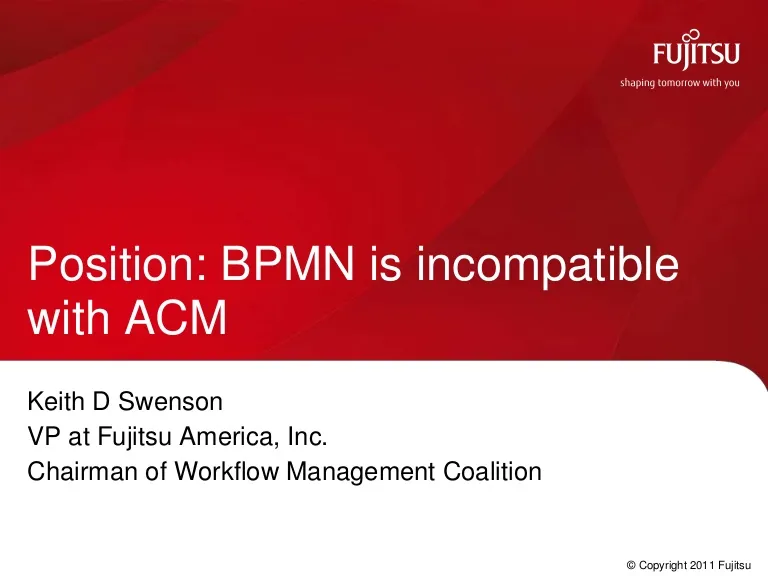Position paperpresentation
Transcript
Position: BPMN is incompatiblewith ACMKeith D SwensonVP at Fujitsu America, Inc.Chairman of Workflow Management Coalition © Copyright 2011 Fujitsu Proposition Any work support system that depends upon processes designed with BPMN (or BPMN-like languages) cannot be considered an ACM system. © Copyright 2011 Fujitsu What is BPMN-like This is not a critique of BPMN in particular. Here, I use BPMN to refer to any flowchart like, two- dimensional process diagram with boxes and lines. © Copyright 2011 Fujitsu Change: Lifecycle BPM ACM & PCM © Copyright 2011 Fujitsu -- 1 -- Drawing a diagram requires a kind ofabstract thinking about the process that a business user is not comfortable with. © Copyright 2011 Fujitsu -- 2 --Drawing an executable diagram actually involves some programmer-like skills © Copyright 2011 Fujitsu -- 3 -- Modifying someone else’s diagram is particularly difficult:the assumptions that went into drawing the diagram are not visible in the diagram The BPMN-like diagram is the output ofplanning, and supporting concepts are lost © Copyright 2011 Fujitsu © Copyright 2011 Fujitsu The Nescafè Process (example from: M zur Muehlen) © Copyright 2011 Fujitsu Web Service Web Service Web Service A B C © Copyright 2011 Fujitsu Can a Step be Inserted? Web Service X Web Service Web Service Web Service A B C © Copyright 2011 Fujitsu Can Steps be Rearranged? Web Service Web Service Web Service A B C © Copyright 2011 Fujitsu © Copyright 2011 Fujitsu Criterion 1: Ability to design a basic process quickly with very little investment by the user is far moreimportant than the ability to define a precise process which uses more time an attention from the business user. © Copyright 2011 Fujitsu Criterion 2:Process design must not require a skill beyond what business users possess © Copyright 2011 Fujitsu Criterion 3:For a process definition to be modified by business users there must be no hidden assumptions. © Copyright 2011 Fujitsu For Routine Work For Knowledge WorkCreated ahead of time Created when needed,by specialist crafted to by the person doing the work.automatically respond Manually adjusted forto many situations. changing situations. © Copyright 2011 Fujitsu The simple checklist Boil the water Put coffee in the cup Put boiling water in the cup © Copyright 2011 Fujitsu The simple checklist Boil the water Put coffee in the cup Put sugar in the cup Put boiling water in the cup © Copyright 2011 Fujitsu Why Not BOTH? If a system has BPMN, then 5% will use it95% will be unable to modify those diagram The system will no longer be adaptive © Copyright 2011 Fujitsu Conclusion For all participants to be able to adapt processes to their need, all processes need to be in low-tech form You must force all users into a least-common-denominator situation, using the low-tech form The mere presence of a flow-chart format will disrupt the ability to be adaptive. © Copyright 2011 Fujitsu What are the open questions that need to be answered? © Copyright 2011 Fujitsu
